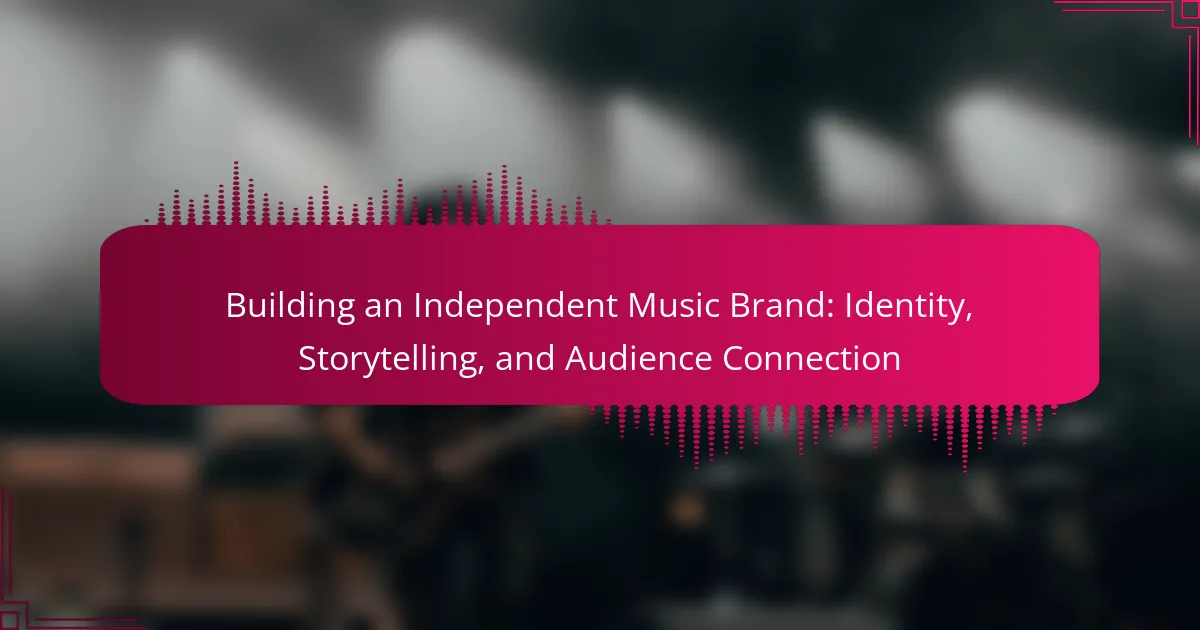Musicians can significantly boost their income by monetising music through merchandising. This involves creating unique products that resonate with fans, focusing on quality and design. Key strategies include understanding target audience preferences, utilising various sales channels like online stores and live events, and implementing effective marketing tactics. Engaging fans through exclusive offers and collaborations can further enhance brand loyalty and revenue.
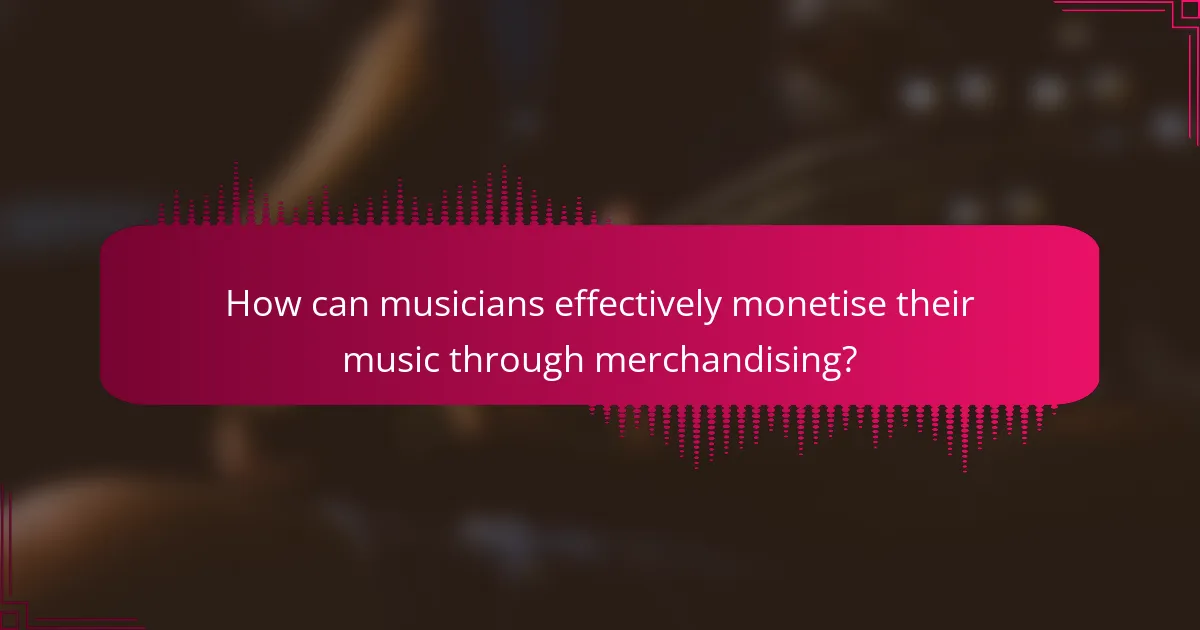
How can musicians effectively monetise their music through merchandising?
Musicians can effectively monetise their music through merchandising by creating unique products that resonate with fans. Offering items like apparel, accessories, and limited-edition collectibles can enhance brand loyalty and generate revenue.
Successful merchandising involves understanding the target audience’s preferences and trends. Production should focus on quality and design that reflects the artist’s identity. Sales channels include online stores, social media platforms, and live events, providing multiple avenues for reaching potential buyers.
Engaging fans through exclusive merchandise offers, such as pre-orders or bundles, can drive sales. Collaborations with local artists or brands can also expand reach and diversify product offerings.
Effective marketing strategies, including social media promotions and email campaigns, are essential for driving traffic to merchandise sales. Analysing sales data helps refine product offerings and optimise pricing strategies, ensuring sustained profitability in merchandising efforts.
What are the key benefits of merchandising for musicians?
Merchandising offers musicians significant benefits, including increased revenue, brand visibility, and fan engagement. By selling merchandise, artists can diversify income streams beyond music sales and streaming royalties. Merchandise also serves as a marketing tool, promoting the artist’s brand and expanding their reach. Additionally, well-designed products can foster a deeper connection with fans, enhancing loyalty and community.
Which types of merchandise are most popular among fans?
Apparel, accessories, and vinyl records are the most popular merchandise types among music fans. Apparel includes t-shirts and hoodies featuring band logos and album artwork. Accessories like hats, pins, and bags also attract fans. Vinyl records have gained renewed interest, appealing to collectors and audiophiles. These items not only generate revenue but also strengthen fan engagement and brand loyalty.
How do musicians choose the right merchandise for their audience?
Musicians choose merchandise based on audience preferences, brand alignment, and market trends. Understanding the demographic helps tailor products that resonate. Engaging with fans through social media can reveal desired items, ensuring relevance. Collaborating with designers can enhance uniqueness, while quality production maintains brand integrity.

What are the essential steps in the production of music merchandise?
The essential steps in the production of music merchandise include designing, sourcing materials, manufacturing, and distribution.
1. Design: Create unique artwork that reflects the music brand.
2. Sourcing: Identify suppliers for quality materials and printing services.
3. Manufacturing: Produce the merchandise, ensuring quality control throughout the process.
4. Distribution: Develop sales channels, including online platforms and physical events, to reach the target audience.
These steps ensure effective monetisation of music through merchandise.
How does the design process impact merchandise appeal?
The design process significantly enhances merchandise appeal by creating a strong visual identity. Effective design captures attention, communicates brand values, and fosters emotional connections with fans. Unique attributes, such as limited edition designs, can further increase desirability and sales potential. Engaging designs can lead to higher perceived value, encouraging purchases and promoting brand loyalty.
Which production methods are best suited for different merchandise types?
Different merchandise types require tailored production methods to maximise quality and profitability. For apparel, screen printing is effective due to its vibrant colours and durability. For accessories, sublimation printing offers detailed designs on various materials. For physical media, such as vinyl records, traditional pressing ensures sound quality. For digital products, print-on-demand services provide flexibility and reduce upfront costs. Each method aligns with specific merchandise attributes, enhancing overall sales potential.
What factors influence the pricing of merchandise?
Several factors influence merchandise pricing in music, including production costs, brand value, target audience, and market demand. Production costs encompass materials, labour, and shipping expenses, directly impacting retail prices. Brand value reflects the artist’s popularity and perceived worth, often allowing for higher pricing. Target audience demographics determine what consumers are willing to pay, while market demand fluctuates based on trends and competition. Understanding these elements helps optimise pricing strategies for music merchandise.
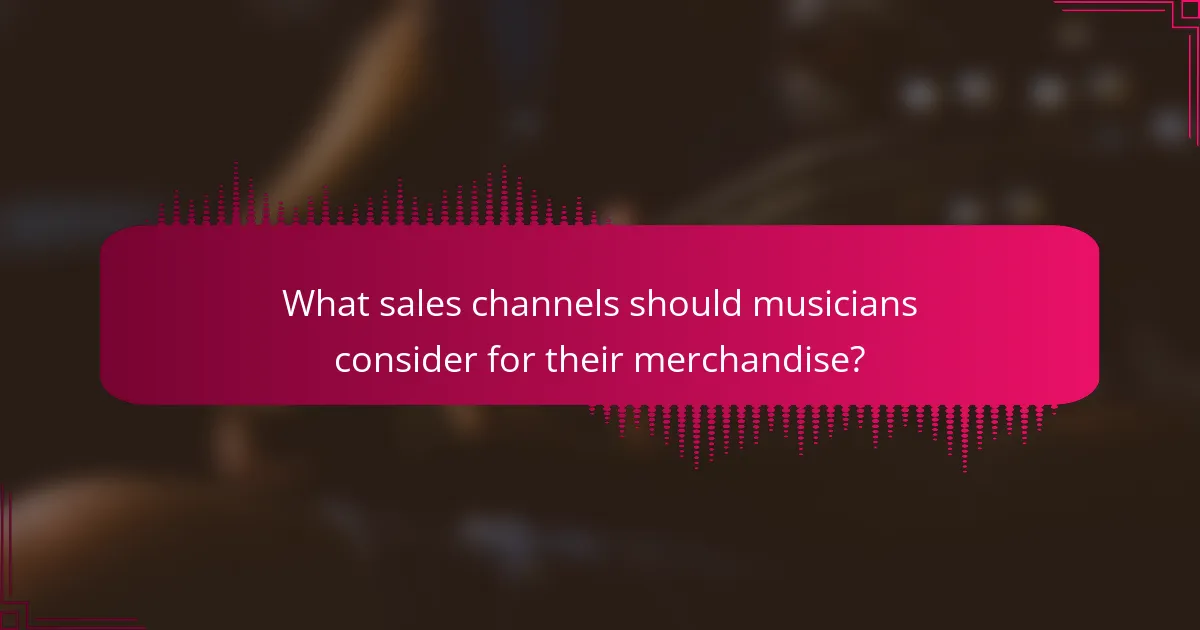
What sales channels should musicians consider for their merchandise?
Musicians should consider various sales channels for their merchandise, including online stores, social media platforms, live events, and music festivals. Online stores enable direct sales to fans, while social media platforms facilitate promotion and engagement. Live events provide opportunities for on-site sales, and music festivals reach a broader audience. Each channel offers unique benefits for maximising merchandise revenue.
How do online platforms compare to physical sales in merchandising?
Online platforms generally outperform physical sales in merchandising due to their broader reach and lower overhead costs. They enable musicians to access global audiences without geographical limitations. Online sales allow for real-time inventory management and targeted marketing, enhancing customer engagement. Physical sales, while providing tangible experiences, often incur higher costs for production and distribution. As a result, musicians can benefit significantly from prioritising online merchandising channels.
Which social media strategies can enhance merchandise sales?
Utilising social media strategies can significantly boost merchandise sales for music artists. Engaging content, influencer partnerships, and targeted ads can drive traffic to merchandise platforms.
Promotional campaigns showcasing exclusive merchandise can create urgency. For example, limited-time offers or bundles can encourage fans to purchase. User-generated content featuring fans wearing merchandise can enhance brand loyalty and visibility.
Platforms like Instagram and TikTok are ideal for visual storytelling. Artists can share behind-the-scenes content, product launches, and live interactions to connect with their audience. Analytics tools can help track engagement and optimise strategies.
Collaborating with influencers can expand reach. Influencers can showcase merchandise to their followers, increasing exposure. This strategy leverages their established trust and connection with fans, driving sales effectively.
What role do live events play in merchandise sales?
Live events significantly boost merchandise sales by creating unique, immersive experiences. Fans often purchase items to commemorate their attendance and connect with the artist. Additionally, exclusive event merchandise can drive demand, offering fans a sense of ownership and belonging. The atmosphere of live events fosters a strong emotional connection, leading to increased impulse purchases. As a result, artists can enhance revenue streams through strategic merchandise offerings during performances.

How can musicians integrate their brand identity into merchandise?
Musicians can effectively integrate their brand identity into merchandise by aligning design elements with their artistic vision. Key strategies include using consistent logos, colour schemes, and themes that resonate with their music style. Collaborating with designers who understand the brand can enhance this alignment.
Offering exclusive merchandise that reflects the musician’s personality or story creates a unique connection with fans. Limited editions or artist signatures can increase perceived value. Utilising online platforms and social media to promote merchandise ensures broader reach and engagement with the audience.
Incorporating fan feedback in merchandise design can foster loyalty and create a sense of community. Engaging fans through polls or contests can yield ideas that resonate well.
Finally, storytelling on product pages can strengthen the emotional connection. Sharing the inspiration behind the merchandise can turn casual buyers into devoted fans.
What unique attributes can differentiate a musician’s merchandise?
Unique attributes that differentiate a musician’s merchandise include limited editions, personalised items, collaborations with artists, exclusive designs, eco-friendly materials, and unique packaging. These elements enhance the value and appeal of the merchandise, creating a stronger connection with fans.
How can storytelling enhance the emotional connection with merchandise?
Storytelling enhances emotional connections with merchandise by creating relatable narratives that resonate with fans. These stories can evoke nostalgia, highlight personal experiences, or reflect the artist’s journey, making the merchandise more than just a product. Engaging narratives foster a sense of belonging and loyalty, encouraging fans to invest emotionally and financially in the artist’s brand. This connection can lead to increased sales and a deeper appreciation for the music itself.
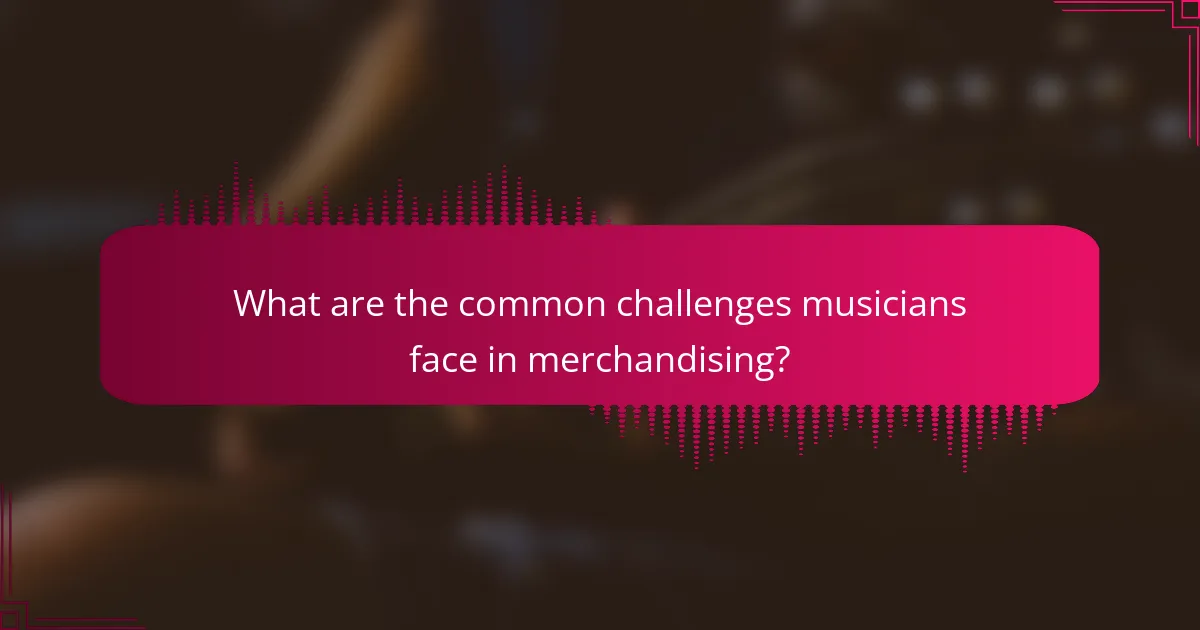
What are the common challenges musicians face in merchandising?
Musicians face several common challenges in merchandising, including production costs, inventory management, and marketing. High production costs can limit the types of merchandise offered. Managing inventory effectively is essential to avoid excess stock or shortages. Additionally, reaching the target audience through effective marketing strategies poses a significant hurdle. Understanding sales channels, such as online platforms and live events, is crucial for maximising revenue.
How do musicians navigate inventory management and fulfilment?
Musicians navigate inventory management and fulfilment by leveraging online platforms and third-party services. They utilise e-commerce tools to track merchandise sales and manage stock levels efficiently.
Many musicians partner with fulfilment centres that handle storage, packaging, and shipping. This approach minimises logistical burdens and allows artists to focus on creating music.
Using social media and their websites, musicians promote merchandise directly to fans, creating a personalised shopping experience. Engaging with fans through exclusive offers can boost sales and foster loyalty.
Data analytics tools help musicians understand sales trends and inventory needs, enabling them to make informed decisions about production and restocking. This strategic approach enhances profitability and streamlines operations.
What legal considerations should musicians be aware of when merchandising?
Musicians should be aware of copyright, trademark, and licensing laws when merchandising. Copyright protects original music and artwork, while trademarks safeguard brand names and logos. Licensing agreements are crucial for using third-party content. Understanding these legal aspects helps avoid infringement and ensures proper revenue from merchandise sales.
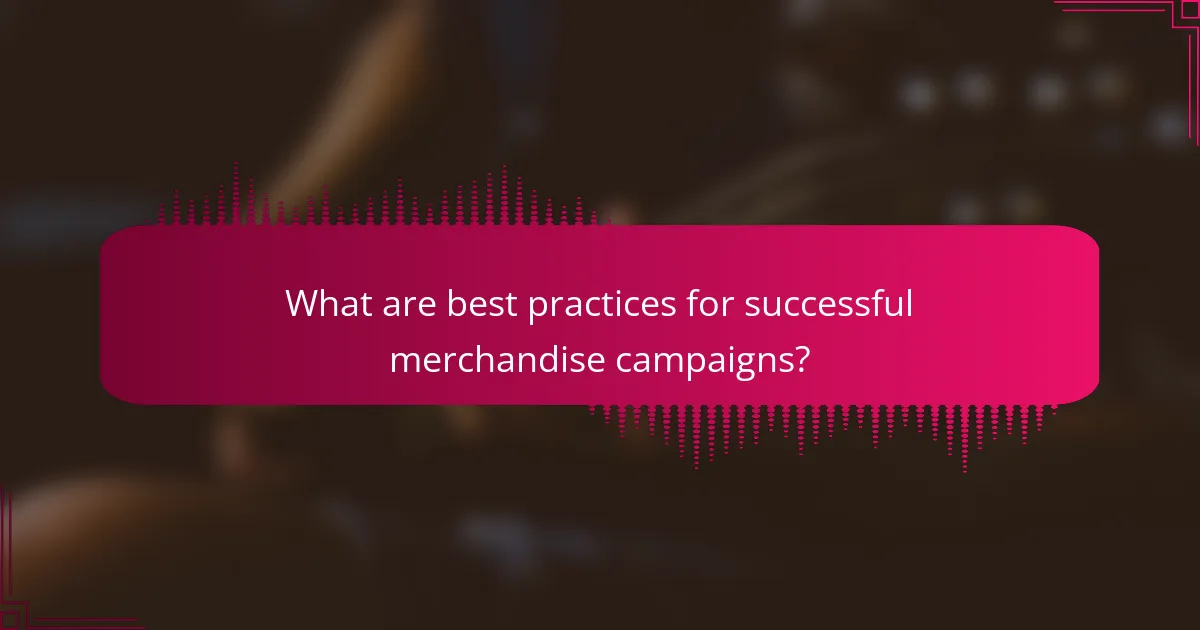
What are best practices for successful merchandise campaigns?
Successful merchandise campaigns leverage strategic planning and creativity. Focus on your audience’s preferences and align products with your music brand.
1. Identify target demographics to tailor merchandise offerings.
2. Utilise high-quality materials to enhance product appeal.
3. Integrate merchandise into live performances for immediate sales.
4. Promote through social media to reach wider audiences.
5. Collaborate with influencers to boost visibility.
6. Offer limited edition items to create urgency and exclusivity.
How can musicians effectively promote their merchandise to maximise sales?
Musicians can effectively promote their merchandise by leveraging social media, engaging with fans, and utilising online marketplaces. Building a strong online presence increases visibility and drives sales.
Social media platforms like Instagram and TikTok allow musicians to showcase merchandise through creative content. Regularly posting updates, behind-the-scenes looks, and promotional offers keeps fans engaged. Collaborating with influencers can also expand reach.
Engaging directly with fans through live streams and Q&A sessions fosters a sense of community. Musicians can highlight merchandise during performances or events, encouraging immediate purchases.
Utilising online marketplaces like Bandcamp or Etsy provides additional sales channels. These platforms cater specifically to artists, allowing for easy transactions and global reach. Offering exclusive items can create urgency and boost sales.
What common mistakes should musicians avoid in merchandising?
Musicians should avoid overpricing, neglecting quality, failing to promote, and ignoring audience preferences in merchandising. These mistakes can diminish sales and damage brand reputation.
Overpricing can deter fans from purchasing merchandise, while neglecting quality can lead to negative reviews. Failing to promote products through social media and live shows limits visibility. Additionally, ignoring audience preferences results in unsold inventory.
Successful merchandising requires understanding the target audience and maintaining high-quality standards. Engaging marketing strategies can enhance sales and strengthen the connection between musicians and fans.
How can musicians measure the success of their merchandising efforts?
Musicians can measure the success of their merchandising efforts through sales metrics, customer feedback, and brand engagement. Analysing revenue generated from merchandise sales provides a clear indicator of financial success. Additionally, tracking customer interactions on social media and at live events can reveal the brand’s resonance with fans. Monitoring the growth of merchandise-related online traffic and conversion rates also offers insights into overall effectiveness. Regularly assessing these factors helps musicians refine their merchandising strategies for better results.



